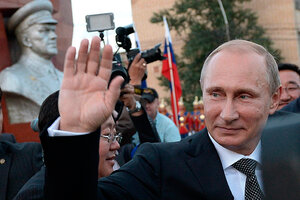NATO summit: Pugnacious Putin provides new purpose for alliance
By invading a neighboring country, Putin has reminded Europe and the Atlantic Alliance that NATO's original purpose – underpinning security and stability in Europe – is still necessary.

Russian President Vladimir Putin waves after a wreath laying ceremony at the monument to Soviet Marshal Georgy Zhukov in Ulan Bator, Mongolia, Wednesday, Sept. 3, 2014.
Alexei Nikolsky/Presidential Press Service/ RIA Novosti/AP
Washington
After a decade of NATO hand-wringing, deep thinks about the Atlantic Alliance’s purpose in a peaceful Europe, and experimenting with “out-of-area” missions like Afghanistan, the organization that anchored the United States in postwar Europe once again seems confident about its 21st century existence.
That restored sense of purpose – which just six months ago seemed too much to hope for at this week’s NATO summit in Wales – can be attributed to no Alliance leader or far-flung mission, transatlantic experts say, but to Vladimir Putin.
By sending its troops over an internationally recognized border and annexing a piece of a neighboring country, Mr. Putin’s Russia has reminded Europe and the 28-member Alliance that NATO’s original purpose – underpinning security and stability in Europe – is still necessary.
“In some ways, NATO should thank Vladimir Putin because it was really searching for its purpose, post-[Afghanistan], and it was having a fairly significant identity crisis as people were looking toward the [Wales] summit nine, 12 months ago,” says Heather Conley, director of the Europe Program at the Center for Strategic and International Studies in Washington. “It has now not only been repurposed,” she adds, “it’s been reinvigorated.”
NATO leaders will still take up Afghanistan – in particular they will discuss how to pay the $5 billion bill to keep Afghanistan’s NATO-trained security forces operational for the coming years, and how much training and other assistance to provide after NATO’s security mission ends in December.
But what was once at the top of the agenda has receded several notches as Russia’s actions in Ukraine and the strong jitters they have sent pulsing through NATO’s former Soviet bloc members have moved to center stage.
“No one predicted that a portion of Europe would be annexed in 2014, that we would basically … have war between Russia and Ukraine,” Ms. Conley says. “I think it’s time we begin to state very clearly what this is,” she adds, “and it has now required NATO to really adapt and change fairly dramatically.”
That adapting is being forced on the Alliance by the spectacle of a Russian triumph in eastern Ukraine even as the NATO summit unfolds.
Opening the summit Thursday, British Prime Minister David Cameron minced no words, declaring that “Russian troops are illegally in Ukraine,” despite official Russian insistence to the contrary.
NATO leaders were set to hold a meeting Thursday with Ukrainian President Petro Poroshenko, the only non-NATO leader invited to the summit. Briefing leaders on a Russia-proposed cease-fire plan for eastern Ukraine, Mr. Poroshenko said he would order a start of a cease-fire on Friday provided that a planned international meeting on the conflict also proceeds on Friday.
The plan would freeze the fighting, a Poroshenko goal, but with pro-Russian rebels holding the territory they’ve taken with Russian assistance – a clear defeat for the Ukrainian government.
With Russia’s expansionist maneuvers overshadowing their summit, NATO leaders are considering creation of a rapid-reaction force to defend threatened NATO members from outside aggression, and positioning more NATO assets in countries bordering Russia and feeling most threatened by it, such as the Baltic states and Poland.
But not all of NATO’s 28 members agree on the degree of the Russian threat, with some governments concerned that any overly assertive action on Russia’s borders would prompt Moscow to reciprocate and thus set in motion a dangerous spiral.
NATO is expected to approve more extensive positioning of Alliance military assets in the “frontline” Baltic states and Poland, but they are expected to be labeled rotating assets to avoid conflicting with a 1997 agreement with Russia that no “permanent” military installations would be positioned in countries bordering Russia.
But even that step was nowhere on NATO’s agenda just a few months ago, and can be attributed to events in Ukraine. A “persistent” NATO presence in the Baltic states and Poland “was never envisioned and would never have been part of the calculation were it not for Vladimir Putin’s actions,” Conley says.
Also anticipated to cause heated debate at the Wales summit is the issue of NATO arming nonmember states – including Ukraine. So far Alliance members including the US have stuck to providing the Ukrainian military with nonlethal material and some intelligence support.
Speculation was growing Thursday that the US would announce some provision of defensive weaponry to Ukraine. But there are indications that even some minimal show of support for non-NATO militaries would not be well-viewed by Alliance publics.
A new Transatlantic Trends survey by the German Marshall Fund finds that while a slim majority of Americans supports arming and training non-NATO militaries like Ukraine’s, an almost identical percentage of Europeans opposes such action.
One reason for that public reluctance is a desire to avoid antagonizing Russia, some foreign policy analysts say. And indeed, even the discussion of increased Alliance assistance to Ukraine was already prompting reactions from Moscow.
Russian Foreign Minister Sergei Lavrov said in Moscow that any steps altering Ukraine’s “neutral” status would pose a serious threat to regional security and prompt a Russian response.
Responding to President Obama’s insistence Wednesday that NATO’s door remains open to countries that meet Alliance standards, including democratic governance, Mr. Lavrov accused the US of choosing the “party of war” in Ukraine.

